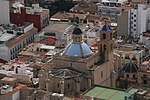Pabellón Pedro Ferrándiz
1993 establishments in SpainBasketball venues in SpainCB Lucentum AlicanteEnric Miralles buildingsIndoor arenas in Spain ... and 4 more
Modernist architecture in SpainSpanish sports venue stubsSports venues completed in 1993Sports venues in the Valencian Community
Pabellón Pedro Ferrándiz is an arena, designed by Enric Miralles, in Alicante, Spain. Formerly named as Centro de Tecnificación de Alicante, it changed its name in honour to the Spanish basketball coach and member of the Basketball Hall of Fame Pedro Ferrándiz on 14 January 2014.The arena holds 5,425 people. It is primarily used for basketball and the home arena of Fundación Lucentum Baloncesto.
Excerpt from the Wikipedia article Pabellón Pedro Ferrándiz (License: CC BY-SA 3.0, Authors).Pabellón Pedro Ferrándiz
calle camino de Ronda, Alicante El Tossal
Geographical coordinates (GPS) Address Nearby Places Show on map
Geographical coordinates (GPS)
| Latitude | Longitude |
|---|---|
| N 38.354027777778 ° | E -0.49458333333333 ° |
Address
Centro de Tecnificación y Alto Rendimiento
calle camino de Ronda
03005 Alicante, El Tossal
Valencian Community, Spain
Open on Google Maps









